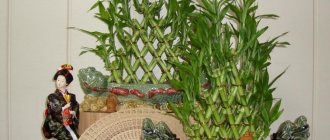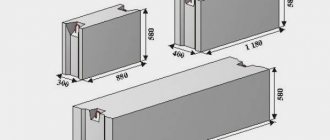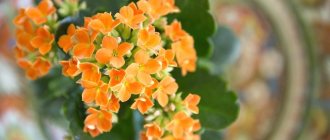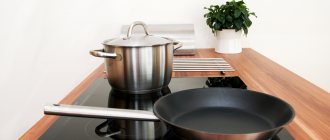Friends, do you want to grow an exotic plant Dracaena Sandera for your office or home? If you don’t have time to grow indoor flowers, find out how to care for indoor bamboo at home. Using my experience, tips and tricks, try growing a whimsical arrangement!
Three-tier composition - decoration for any room
How to grow indoor bamboo plant at home
The evergreen plant belongs to the dracaena family. Bamboo comes in tree and reed varieties. The thickness of the trunk ranges from 2-30 cm. In natural conditions it reaches a height of up to 30 meters. A tree-type flower blooms once every 30 years, a decorative one - every 40 years. After abundant flowering, the bamboo dies.
Comrades, do you want to have an evergreen and flowering plant on your windowsill? Learn how to grow cardamom in a pot.
Decorative bamboo is a decoration for offices and living rooms. It requires a minimum of care, good lighting and mineral fertilizers. General characteristics - a hollow stem, depending on the height, divides plants into groups:
| View | Height | Popular varieties |
| Short | 1m | “Golden Lily”, “Tsuboi” |
| Average | 3.5 m | “Shiroshima”, “Mexican weeping” |
| High | 6 m | “Tropical Black”, “Monastic” |
Fertilizer feeding
Whatever growing method you choose, bamboo needs to be fertilized regularly. For this, organic and mineral fertilizers are usually used. Specialized fertilizers for dracaena can be purchased at flower shops. Their advantage is that they contain a complete set of elements necessary for plants.
During the cold season, fertilizing is carried out several times a month. In summer, it is enough to apply fertilizer once every three weeks. If you notice that a houseplant is growing too slowly, then this is a reason to think about the need for fertilizing.
Experienced gardeners recommend giving preference to growing bamboo in the ground. The plant can survive in water for a year or more. Its lifespan depends on the quality of care. Sooner or later, the bamboo disappears in the water. Therefore, it is better to plant it in the ground so that the crop will please you with its decorative effect longer.
What fertilizers are needed for normal growth of bamboo at home?
The houseplant is unpretentious; any mineral fertilizers with nitrogen-phosphorus content are suitable for dracaenas. If you do not add organic ingredients, the tips of the bamboo leaves will gradually turn yellow or straw-colored, then dry out and fall off. I described how to prevent this in another article. Be sure to read it!
Is it correct to use phosphorus fertilizers?
Yes No, what are you talking about!
Parasites and diseases
Basically, diseases of indoor bamboo appear due to improper care. The plant weakens, loses its immune abilities, and cannot resist harmful infections and bacteria.
Causes and consequences of diseases:
- Excess liquid and stagnation of water in the pan provokes rotting of the root system. Fungal rot appears. Bamboo leaves become dull and lose their elasticity.
- When watering with cold, hard water, the root may freeze. The plant sheds its leaves. It is important to lay a protective layer of drainage on the bottom.
- The plant suffers from irregular or insufficient watering. The turgor of the leaf plate is lost, the leaves curl, the tips turn yellow and dry. A lack of moisture provokes the appearance of dry spotting.
- The leaves grow poorly, the annual growth of the stem is minimal - there is little light and nutrition. The plant absorbs minerals from the soil, fertilizing replenishes the consumption and maintains growth forces.
- An excess of mineral or organic substances in the soil affects the uniform development of the bamboo bush. The leaves are deformed and twisted. It is impossible to exceed the permissible dosage and diet.
Fungicides will get rid of spotting, gray and root rot, and powdery mildew:
- Topaz;
- Colloidal sulfur;
- Previkur;
- Maksim;
- Baktofit et al.
The most common pests of Dracaena Sandera:
- Spider mites start when dust accumulates in the sinuses, on the leaves, and in the internodes. A simple way is to wipe the leaves and stem with soapy water.
- The scale insect makes marks - brown spots appear on the leaves, and reddish-yellow spots form around the plaques.
- The mealybug leaves whitish lumps on the surface of the soil and on the leaves (in the axils).
- Aphids are dangerous sucking pests. Sticky drops of toxic liquid remain on the leaves.
- Thrips are carriers of infection. The bush needs to be treated with Neoron.
Pests are collected mechanically with a swab moistened with special preparations - acetic acid, machine oil or alcohol. In advanced cases, the plant is sent to quarantine. The top layer of the substrate is changed. Leaves and stems are treated with special systemic insecticides:
- Fufanon;
- Aktara;
- Agravertine;
- Fitoverm;
- Aktellik, etc.
How to care for bamboo
I would like to draw your attention to how you care for bamboo depending on the growing environment. The yellowing of the trunk and the pale color of the leaves will remind you that you need to change the water to fresh water or feed the plant. If you forgot about bamboo and did not irrigate the soil for a long time, you can see how the leaves have curled into a tube.
In summer
I water the plant twice a week with settled rainwater. Before watering, I loosen the top layer. I collect fallen leaves for mulch to protect the roots from drying out. In the summer, I take the bamboo out into the fresh air, it will be useful for it.
In winter
With the onset of autumn and until spring, bamboo is in a dormant stage, so I reduce the amount of watering. I moisten the soil once a week using purified or melt water, spray and wipe the leaves. In winter I place the exotic plant in a warm, but not very dry place with a temperature of at least +18 degrees and a humidity of at least 40%. I organize additional lighting using an ultraviolet lamp.
The cold also affects humans; keep a supply of horseradish for the winter to fight diseases.
How to replant bamboo in an apartment
Bamboo is an unpretentious plant; it grows well in water, in soil, and in hydrogel. But he will feel best in the ground.
The process of planting bamboo in a pot is as follows:
- For planting, you need to choose healthy, richly green seedlings that have living, undamaged roots.
- It is better to choose a pot deep enough and spacious enough so that the roots have room to grow. Particular attention should be paid to the drainage holes to ensure the outflow of water from the container.
- The soil, as mentioned above, must be taken ready-made. Expanded clay or small pebbles are suitable for drainage.
- Water for irrigation should be melted or settled.
The drainage layer should be at least 3 cm; moistened soil is placed on it in small portions and a hole is immediately made. The cuttings are taken out of the water, a preparation for root growth should be sprinkled on the roots and a little of this preparation should be added to the hole itself.
The roots are sprinkled with earth, compacted a little, and the pot is completely filled with soil. Water thoroughly so that water flows out through the drainage holes. Water must be removed from the pan so that it does not stagnate.
Watering rules
Many beginners believe that bamboo is a drought-resistant plant and does not need to be watered. Friends, this is a mistaken opinion. The ornamental plant loves water very much, and a deficiency will not allow it to take root in a new place. In order for bamboo to acclimatize to new conditions, follow these rules:
- Water the plant after planting in the ground as often as possible for 3-6 months.
- Fill the plant in the pot with 5 cm of water once every 10 days.
- To retain moisture, use mulch, this is ideal for those who forget to water.
- Touch the soil with your hand, if it is dry, water it.
- Drain excess water from the pan; excessive waterlogging damages the root system and it begins to rot.
- Watch the bamboo; if the leaves are curled, it means it needs watering; if they turn yellow, reduce the quantity and rate.
- Use only purified or settled water; in the water pipe it contains chlorine, this is death for the plant.
Author's note
Natalia Papanova
Blog author
For irrigation, use melt water. Fill a plastic bottle with regular tap water and place it in the freezer.
Watch a video about home care for Dracaena Sandera:
Reproduction
Indoor bamboo can be propagated by cuttings and seeds. At home, propagation by cuttings is most convenient, but we will talk about both methods for informational purposes.
Propagation by cuttings
To propagate bamboo at home using this method, you need to spend a minimum of time and effort. There are several options for cuttings.
- Apical shoot. To obtain a cutting from an adult plant, cut off the top with a sharp tool. The length of the resulting cutting must be at least 15 cm. The cut points must be lubricated with liquid wax to avoid rotting. Then the resulting cutting is placed in water. It is recommended to add a root growth stimulator, such as Kornevit, to the water. After rooting, the cuttings can be planted in the ground and cared for as an adult plant.
- Stem cuttings. This method is used if it was not possible to propagate dracaena using the previous method. The stem is cut from the mother bush and divided into several parts. It is important that there is a growth point on each part. Each part is placed in water for rooting, and then planted in the ground, as in the previous case.
Growing bamboo from seeds
It is almost impossible to propagate Dracaena Sander by seeds at home, because the seeds of this type of Dracaena have very poor germination. Plus, even if you manage to germinate them, you'll run into other problems. Indoor bamboo seedlings require the same daylight hours and the same air temperature throughout the year, and they will also have to maintain the required level of air humidity.
How much light does this houseplant need?
Friends, bamboo needs light and warmth to be completely happy. Choose a place where there is no direct sunlight. The prolonged and powerful effect of ultraviolet radiation is detrimental to the plant. If you put bamboo on a south-facing window sill, provide the windows with blinds that will help regulate daylight.
Decorative flowers love warmth, maintain a comfortable temperature of +22 – +32 degrees. If indoor bamboo falls into frost conditions of -15 degrees, the trunk will remain, but the leaves will darken.
Growing Bamboo
How to grow bamboo at home? It is best to place the plant on an east window. Direct sunlight must be avoided. Despite the fact that the crop is light-loving, too intense lighting can cause burns on it. In addition, dracaena does not tolerate drafts. Ventilation in winter can lead to the death of the plant. In the summer, bamboo needs frequent watering and careful attention to ensure that the soil does not dry out. In winter, moisture should be more moderate.
If you notice that the plant is losing its leaves, you need to increase the light. The tallest plants should be planted in large pots, which can later be placed in a place with diffused light. It is necessary to monitor air humidity. Dracaena does not feel very comfortable in a room with dry air.
How to propagate bamboo at home
There are three ways to propagate bamboo by cuttings, seeds and root division. The first method is the most popular at home. The seed method is used less frequently; the seed forms the root system over several months. By dividing the root, it is propagated when replanting the plant.
If you wait a long time for bamboo seedlings, you can grow honeysuckle, find out how to do it quickly.
I advise you three options for propagation by cuttings:
- Cut off the top of the mother plant with leaves at least 15 cm long, place it in water, adding 1 drop of root growth stimulator per 1 liter of water.
- If the top part of the plant does not take root, try the stem method. Divide the mother plant into several parts, which are placed in water.
- If the plant is old and weakened, try the knee propagation method. Select the greenest part, cut off the part from the mother plant just above the junction of the segment and place it in water.
Bamboo cuttings have given roots and are ready for planting in soil
If you want to start growing bamboo as a small business, try growing the plant from seeds, following the recommendations:
- Soak the planting material in water for a day, during which time the embryo will hatch.
- Prepare a special substrate from soil, ash and wood shavings.
- Mix all ingredients and sift through a sieve to remove debris and stones.
- Fill a plastic container with the prepared substrate, make grooves 2-5 mm deep and stick the seeds at a distance of 5-10 cm, sprinkle with soil, then pour with warm water.
- Provide seedlings with warm conditions and lighting at night under phytolamps for at least 6 hours.
- When the first shoots hatch, transplant into individual containers using a substrate of peat and soil.
Reproduction by dividing the root system is the simplest; planting material takes root quickly. Fill the soil in the pot well with water and leave for 30 minutes. Take out the bamboo along with the lump, wash it from dirt, and carefully cut off the required number of shoots. You can root them directly into the ground or immerse them in water.
You can decorate living spaces not only with bamboo; pay attention to homemade sage. In addition, it is grown not only for beauty, but also for medicinal purposes.
Twisting into a spiral
Often, you can find specimens of indoor bamboo for sale with original and bizarre shapes. This is facilitated by the distinctive ability of the stem to bend and remember its shape. We'll tell you how to achieve this shape at home.
Method 1. Place a stick, cylinder or any other support of the required shape in a flower pot and wrap the stem around it. At first, the structure must be secured with wire. Once the stem becomes woody, the wire and stick can be removed.
Method 2. Cover the pot with the plant with a box so that one side flap is open. The remaining doors and the top must be closed. Then the light will enter the box only from one side - this is where our bamboo will stretch as it grows. After a while, when you can see the stem tilting to one side, turn the box so that the sun hits the dracaena from the other side. So, by constantly turning the box, you can curl the stem of your specimen into a spiral. But this method is very long - one turn can take up to a year.
This may be interesting: Description of types and varieties of Tradescantia
You can create other, more complex compositions from indoor bamboo, but we’ll talk about this some other time.
Features of caring for bamboo if it grows in water
My dears, caring for a plant if it grows in water is very simple; it feels comfortable in any environment. Change the water once a week, adding activated carbon once a month.
If you want to grow a healthy plant at home without any problems, read about tarragon. This amazing herb fills your home with an amazing aroma and can be used in drinks and salads.
For fertilizing, use liquid nitrogen-phosphorus fertilizers. To avoid causing strong growth, reduce the recommended amount on the package by 5 times. Use foliar fertilizers more often.
Be sure to fill the roots with water 2 cm above their level
Growing in hydrogel
Bamboo can be grown in hydrogel. This method is the least common. The plant is placed in a container, which is filled with water and hydrogel. As the capsule is used, the substances gradually change their shape and color.
Such cultivation does not cause much trouble for the gardener. Fresh water must be added to the vessel as needed. In addition, dracaena is fertilized twice a month.
How often do you need to replant bamboo and renew the soil?
If the surface layer of the earth is covered with a gray-white coating, the roots of the plant begin to rot from excess moisture. To replace the soil, I take the root ball out of the ground, wash it and disinfect it. I prepare the substrate for transplantation as for initial rooting in the soil.
Author's note
Natalia Papanova
Blog author
Replant a young plant once a year, an adult plant once every three years, increasing the volume of the container.
Watch the video on how to properly root a plant:
FAQ
Natalia Papanova
Blog author
Ask your question
Often, when growing a houseplant, the following questions arise: which type is best to grow, how long it takes to grow, and how to save it if you forgot to water it. My dears, I answer some of them:
Which variety is best to choose for growing?
Choose a low-growing variety of bamboo, the most suitable option being Dracaena Sandera. This plant does not require much space or care; it looks good in a transparent flowerpot with decor and a regular flower pot.
Is it necessary to prune?
Carry out pruning as it grows; new shoots will appear from the bud below the cut point, and the trunk will begin to gradually thicken. If you don't do this, the plant will look like a long fishing rod with leaves on top.
How to revive a plant if you forgot to water it?
Complete yellowing of the leaves and drying out indicates that you did not water the soil. Restoring bamboo is easy. Water the plant abundantly with water, remove the root ball, rinse and place in an aqueous medium with the addition of activated carbon.
How long does bamboo usually take to grow?
It is impossible to say how many years bamboo will grow at home. In nature this is 30-40 years. It all depends on the care. If you keep bamboo in water for up to two years without proper care, it may die. Therefore, it is better to immediately place the plant in the soil.
Do you believe that bamboo can be grown for 30 years?
Of course not
Home plant
Not everyone knows that indoor bamboo is not related to the bamboo that grows in the wild. At home, we grow one of the varieties of a very popular crop - dracaena, or, to be more precise, Dracaena Sander.
The plant is a bare stem with several leaves at the top. The trunk can be straight or bent in a spiral. Typically, indoor bamboo is painted bright green. Sometimes there are golden-colored plants. If the crop is exposed to bright sun during the day, its color becomes dark green.
Many gardeners ask the question: “Is it possible to grow bamboo at home?” After all, it is considered a plant that brings good luck and happiness. Apparently, for this reason the plant is popular. If you place bamboo in the southeastern part of the house, you will certainly be blessed with good luck and financial stability.
Indoor bamboo (Dracaena Sandera)
Indoor bamboo appeared in our homes relatively recently, but immediately gained popularity among amateur gardeners, and especially beginners. Homemade bamboo is very simple, and even a child can be trusted to care for it.
A little about indoor bamboo
In fact, what we call domestic bamboo has nothing to do with this plant. All these intricate spirals and knotty sticks with leaves are one of the varieties of dracaena. And she bears the name Dracaena sanderiana . It is called bamboo because of the knotty stems characteristic of bamboo. Moreover, this dracaena was previously classified as a member of the bamboo subfamily, then it was moved to the agave family, and now it occupies a place among the dracaenas. But among the people, Dracaena Sandera has remained an indoor bamboo. It is often called “Happiness Bamboo” or “Lucky Bamboo”.
The nodes on the stem of the plant, which give Dracaena Sander its resemblance to bamboo, are actually kind of buds from which new shoots develop. You can become the owner of indoor bamboo quite by accident. The fact is that this plant is very loved by bouquet makers. Over time, the flowers of such a bouquet inevitably fade, and indoor bamboo, being in water, on the contrary, begins to acquire roots and awaken to a new life. This is another advantage of Dracaena Sander over other indoor plants. After all, it can be kept simply in a vessel with water, it can be placed in a hydrogel or planted in the ground. Its plasticity is also attractive. Young indoor bamboo easily curls into a spiral, the stems intertwine with each other, which allows you to give the plant the most bizarre shapes.
Indoor bamboo is widespread among Feng Shui lovers. It is believed that it brings happiness, prosperity, love, prosperity and many other benefits to the house. In China, the number of stems of the Lucky Bamboo has a certain meaning. For example, three stems attract happiness, five - material well-being, seven - health. Twenty stems are called the “Tower of Happiness” and are given to the most dear people. And in Japan, indoor bamboo is considered a symbol of strong character, courage and is a good gift for men.
Growing conditions
Flower growers recommend growing Dracaena Sandera not in soil, but in water. This is explained by the fact that it is in water that there are the most favorable conditions for the full growth and development of the plant. In addition, the roots of the flower are constantly in water, and this minimizes the risk of developing a lack of moisture and withering of the plant.
A beautiful glass vase with decorative elements placed on the bottom is perfect as a container for water. It is important to consider that tap water is not suitable for Dracaena Sandera; moreover, it is destructive for it. For growing Dracaena, the best option is melt or rain water.
However, bamboo also feels good in the ground. To grow the plant, you do not need any special soil; a universal soil for indoor plants is quite suitable. You can prepare the soil yourself by combining sand, humus, peat, foliage and turf soil in equal parts. The only important requirement when breeding Dracaena.
Sander is the presence of drainage holes in the pot. If there are no holes, this can lead to stagnation of water in the pot, mold formation and damage to the plant's root system. In addition, to eliminate increased soil moisture in the pot, it is recommended to lay additional drainage made of pebbles and expanded clay at the bottom of the pot.
It should be done no more than once a year and preferably in the spring. When replanting, be sure to change the soil.
Indoor bamboo is a heat-loving and light-loving plant. It is recommended to place the pot with the plant in a warm and well-lit place, but protected from direct sunlight. You should not place the flower near a radiator or any heating device, as the air around them is very dry. In summer, a pot or vase with a plant can be taken out into the open air. At the same time, the flower is very unpretentious to air temperature; it feels equally good both at +17o C and at + 35o C.
Caring for indoor bamboo
Dracaena Sandera is quite unpretentious, does not require special care and increased attention to itself. The main requirement for successfully growing a plant is timely, sufficient watering.
- In winter and during the off-season, bamboo must be watered moderately, but not allowed to dry out. In the summer, especially on hot days, watering should be abundant and frequent, as the soil in the pot dries. The yellow tips of the plant's leaves will indicate that the watering regime has been disrupted. You should not water the plant with tap water, as the chlorine in it can destroy it.
- The plant does not need high air humidity in the room, so there is no urgent need to spray the leaves of the plant. However, during periods when the air around the plant is particularly dry, you can spray it with water from a spray bottle.
- Like most plants, bamboo needs... It is allowed to fertilize by adding organic liquid fertilizers based on peat or mineral fertilizers to the soil. In summer you can feed bamboo every 3-4 weeks, in winter less often.
Decorative bamboo belongs to the Dracaena family. This one can reach a height of 2 m. But wild bamboo grows much higher. Bamboo naturally grows in the subtropics and tropics, as well as in the mountains. Bamboos can be tree-like or herbaceous. The thickness of the trunk varies from 2-3 to 30 cm. The stem of bamboo can branch, this makes grassy bamboo look like a tree. The plant grows very actively and under good conditions can be approximately 30 meters in height. Reed bamboo is considered poisonous. Flowers on tree-like bamboos appear once every 30 or 60 years.
Decorative bamboo: secrets of care and cultivation
The popular houseplant, known to many as lucky bamboo, is similar to wild Asian bamboo only in appearance, but originates from the forests of tropical Africa. The real name of decorative bamboo is Dracaena Sandera, and it belongs to the Asparagus genus. Confusion does not prevent the elegant plant from being successfully cultivated indoors. It does not require special care, and besides, the flower is endowed with the property of attracting prosperity and good luck to the house.
Indistinguishable from bamboo Source images.wemystic.com
What does it look like
Dracaena sandera is a perennial evergreen plant with attractive characteristics:
- The flower has a fleshy segmented stem, with characteristic constrictions reminiscent of bamboo. Initially plastic, over time the stem hardens, especially at the junction of the segments.
One of the varieties of dracaena Source fermer.blog
- The top is crowned with light green, single-color, lanceolate-shaped leaves, glossy in appearance and dense to the touch. Some hybrid varieties have more interesting leaf colors: stripes or with a border around the edge, light or dark.
- When grown indoors, dracaena grows to a height of up to one meter.
Composition of several stems Source www.hortipoint.nl
- Not all varieties bloom at home, and flowering itself occurs rarely and coincides with the warm season. Small white buds are collected in inflorescences.
- The leaves and stems of dracaena are mildly toxic and can cause symptoms of poisoning in a dog or cat that tries them.
Be careful with pets! Source mothership.sg
In specialized stores you can most often find dracaena with a spiral-shaped stem; This is how they represent it: “spiral bamboo.” A barrel twisted into a spiral is not a natural feature; the effect is created artificially.
The stem of a young plant, until it becomes woody, is particularly flexible and pliable. Gardeners have learned to use this property by practicing bending shoots in different ways. After the plants reach a certain age, the auxiliary parts are removed, and the shoot retains its spiral shape.
In Asian style Source deloindom.delo.si
How to grow
Due to its appearance, decorative indoor bamboo is an ideal option for home landscaping. It is also recommended to be grown in the winter garden and used in floral arrangements. The flower looks good both individually and in group planting. It is proposed to contain Dracaena in three ways:
- In water. To prevent the stems from starting to rot, pour a little water, a couple of centimeters above the root system. Clean water is suitable for use (chlorinated tap water must be settled), which is changed every 7-10 days. Periodically, the plant is fed with mineral fertilizers (according to the instructions), adding them directly to the water.
In the water Source 2.bp.blogspot.com
- In the ground. Before planting in the ground, bamboo is given time to develop a sufficient root system. The pot should contain not only soil, but also a drainage layer (expanded clay or pebbles are suitable). The soil should be light and dry quickly after watering. A ready-made substrate for dracaenas is ideal, as is a mixture for palm trees or ferns.
Using decor Source www.thespruce.com
- In hydrogel. Bamboo in a clear container filled with colorful hydrogel beads is an acceptable decor for most styles. Hydrogel balls are filled with clean water according to the instructions; The filler is enough for 2-3 years of use. Caring for the plant consists of periodically adding water and fertilizing with mineral fertilizers. If the granules are large, you need to make sure that the roots are not exposed to air.
In hydrogel Source obustroeno.com Services for design and implementation of landscape work of any complexity
Principles of care
Bamboo is not particularly picky and adapts to a fairly wide temperature range. The plant does well in temperatures between 18 and 35°C, but should not be placed in front of an air conditioner or vent. When breeding dracaena, it is useful to adhere to the following maintenance recommendations:
- Lighting. Decorative bamboo, native to shady tropical forests, does not like direct sun, so it is not left on the windowsill for a long time. At the same time, the place should be sufficiently illuminated, possibly with the help of artificial lighting.
In the interior of the kitchen Source attuale.ru
- Humidity. Dracaena Sandera is not picky about humidity levels; she is quite happy with the air of modern apartments. If the atmosphere is too dry, it is recommended to wipe the leaves from time to time with a damp cloth and spray them periodically.
Spraying Source www.rd.com
- Watering. The best option would be to use soft water (for example, melt water), but settled water is also suitable. The plant does not respond well to drought, so you need to carefully monitor the soil moisture or water level. On average, water is added (or changed) once a week.
Bamboo needs quality water Source cf.ltkcdn.net
- Feeding. In stores it is often customary to overuse fertilizers, so after purchasing bamboo you should wait 1-2 months before starting fertilizing. All additives are added according to the recommendations; for dracaena in water, the dosage is reduced.
Plants ready to plant Source iorigen.com
- Trimming. It is necessary so that the flower does not lose its decorative effect by stretching beyond measure. The bamboo is simply shortened to the desired height, and a new plant is sprouted from the cut top.
Reproduction, planting and transplantation
It is recommended to do this in the spring, due to the fact that young shoots grow on the stems, which are cut into. To get the cuttings to take root, you can put them in a glass of water and wait for the roots to grow, or you can plant them in soil that is suitable for growing bamboo.
Choose a spacious pot as bamboo grows very quickly, both its stems and roots.
The soil is made from a mixture of equal parts of peat and sand; the pot must have holes for drainage. It is best to combine propagation with transplantation. also required to be done in the spring. This is done once every 2 years. Newly transplanted bamboo and cuttings require very careful care. They need to be watered, wipe the leaves, loosen the soil to improve oxygen access to the rhizomes, then they will grow faster.
When you first bring the plant and plant it, it especially needs plenty of watering, since at first bamboo has small roots, it needs a lot of water to grow.
Transplanting indoor bamboo:
- The roots of the plant grow very actively, so it is recommended to replant it annually. Take a larger pot than the previous one for replanting.
- The pot should be deep and wide, there should be a distance of 5 cm from the stems to the edge of the pot.
- Pour drainage into the bottom of the pot, then a little soil, then plant the bamboo, fill the roots with soil, compact it a little and water it generously.
You need to place the bamboo roots in water, then it will grow quickly, under these conditions it grows up to 0.8-2 m. But you need to remember that the water is changed once a week.
Bamboo feeding:
- Once every 2-3 months, bamboo is fed by dissolving fertilizers in water.
- Add complex to fresh water when you change it.
- If the plant does not have enough fertilizer, its leaves turn yellow and fall off.
- But you can’t immediately feed them, as soon as you bring the bamboo stems home, place them in water and wait for them to get used to room conditions, only then feed them.
Bamboo requires equal amounts of light and shade. Several stems of bamboo are tied with a ribbon of any color and placed in water in a glass or other container. Then they place it on the windowsill. If your bamboo is very long, then place it in a bucket of water or a vase and place it on the floor near the window.
Do not use regular tap water. Only soft and well-settled water is suitable. It is good to use melt water. Pour water into a plastic bottle and place it in the freezer for 2 days. Next, defrost it to room temperature and you can use it; this will make the water soft. The water must not stagnate, otherwise the bamboo will begin to rot.
If your bamboo is in a glass vase, then place pebbles or shells at the bottom; before placing them in the vase, you need to pour boiling water over them so that they do not contain harmful microorganisms.
It is advised to add coal to water to prevent harmful bacteria from multiplying in it. The water for caring for indoor bamboo should be taken exactly the same as for it - melt or rain, and change it in the vase every week. Rare water changes can lead to the formation of mold on the flower.
When caring for bamboo that grows in the ground, it is necessary to water it regularly. In winter, water the bamboo more moderately, making sure that the moisture does not stagnate in the ground. Excess moisture can cause mold to appear, so the pot should have holes and fill the bottom with broken bricks or other materials. Bamboo is also fed from time to time. Another 3 times a week and periodically wipe the leaves from dust.
For normal growth, a tray is placed under the pot and small crushed stone is poured into it.
Then pour water, but so that the crushed stone is not completely covered with water. The pot must be secured above the tray so that it does not have direct contact with water. It is necessary to prevent the soil from drying out, as in this case the bamboo leaves turn yellow and the plant dies.
The plant is fertilized from October to March - once every 3 months, and the rest of the time - every 20 days. Bamboo especially requires phosphorus and nitrogen; you can purchase special fertilizer for dracaenas. The air in the room should be humid. Bamboo loves fresh wind, but does not tolerate drafts. Bamboo can be trimmed throughout the year. Eliminate weakened stems. It is recommended to take the plant out onto the loggia or balcony in the summer.
Indoor bamboo (Dracaena Sandera) - care at home
Conditions of detention
Dracaena Sandera prefers a well-lit place, protected from direct sunlight. When choosing a place for it, ensure a flow of fresh air. Normal room temperature is quite suitable for indoor bamboo, although it can withstand higher temperatures, up to +35 degrees.
Keeping indoor bamboo in water
In this environment it looks very impressive and, importantly, requires a minimum of attention. At the same time, keep in mind that it will also need nutrients; without them, bamboo will not be able to develop normally, and the leaves will turn yellow. It will be enough to add fertilizer for dracaenas to the water once every two weeks, in half the dose recommended in the instructions. Water for bamboo should be well settled or distilled. The best option is to let the water stand and soften it by putting a little peat wrapped in a napkin in a bowl overnight. Rain or snow water is often used.
Advice. The dracaena trunk should only be slightly immersed in water, a maximum of three to four centimeters. Otherwise, there is a possibility of trunk rotting.
Growing Dracaena Sandera in the ground
An earthen mixture for dracaenas with the addition of a small amount of sand is suitable for this growing method. This method is somewhat inferior in decorative value to keeping it in water, but indoor bamboo will feel better in the ground and develop much more actively. Do not allow the soil to dry out for a long time. Overdrying the earthen clod will destroy the lucky bamboo. Water as soon as the top layer of soil dries out.
Propagation of indoor bamboo
After a while, Dracaena Sandera will stretch, the stem will become woody and dark. In this case, it will be necessary to rejuvenate indoor bamboo and grow a young plant. It's very easy to do. It is enough to cut off the green top and place it in water or light soil. Very soon she will sprout her roots.
Maintaining decorativeness
As indoor bamboo develops and grows, it grows side shoots. With these shoots, Dracaena Sandera looks ugly and neglected. Remove them as they appear. When growing in water, do not forget to monitor its level. If you grow in the ground, replant every year.
Formation of indoor bamboo
This is a very interesting and exciting activity. As already mentioned, the tables of this plant are very plastic and can be easily formed. But sometimes they say that it is very difficult, if not completely impossible, to give the bamboo of happiness a neat and beautiful shape at home, and that this can only be done in an industrial environment. This is wrong. If you have the desire, effort and patience, you can achieve very interesting results.
The most popular shape is the spiral. The easiest way to get this shape is to place the growing trunk in a special spiral-shaped glass tube. In the tube, the stem of indoor bamboo grows and gets stronger, and after removing the tube it retains its given shape. Unfortunately, such tubes cannot be purchased at every flower shop. It is much easier to intertwine the trunks of Dracaena Sander with each other, securing them in places of interweaving with soft wire.
Babmub in open ground: planting and care
Choose frost-resistant bamboo varieties. These varieties are: Kuril Sasa (Sasa kurilensis), Sasa Palmata Nebulosa, Phyllostachys Aureosulcata. The most frost-resistant bamboo variety is Fargesia Murielae. Very often the plant is planted near bodies of water, as it loves moisture very much. It should be planted from March to September so that the plant has time to take root and survive the winter. Bamboo likes soil that has an acidity pH of 6.0-6.2.
Place the bamboo pot in a container filled with water for 3-4 hours so that the roots are saturated with water.
Landing Features:
- The hole should be 2 times greater in depth and width than the bamboo roots with soil.
- Add humus to the soil.
- Place a little of this soil at the bottom of the hole and compact it.
- It is best to dig a sheet of metal or plastic around the hole in a circle to prevent the roots from growing throughout the garden.
- Place the bamboo, whose roots are saturated with water, in the hole in the center, add soil, compact it a little so as not to damage the roots and there are no air pockets.
- Pour 5 cm of soil on top. Water generously. Mulch the soil with a 2-5 cm layer of leaves, peat, hay.
If you plant bamboo in the fall, then add 20 cm of manure to the bottom of the planting hole, then 10 cm of garden soil, then plant the plant. Then in winter the manure will decompose, and after that you will not need to feed the bamboo for 2 years.
Care Tips:
- For the first three months, water the plant very abundantly; do not allow the stems to dry out. Then water 2-3 times a week. It loves fertilizers with a high nitrogen content, that is, the proportions of fertilizer are: 4 parts nitrogen, 3 phosphorus, 2 parts potassium.
- Apply in early spring. Next, fertilize the bamboo in the summer. In the fall, feed the plant: 2 parts nitrogen, 4 parts phosphorus, 4 parts potassium, then it will stop growing so actively and prepare for frost. In autumn, mulch the plant with a 10 cm layer of pine bark and leaves. Trim old stems at ground level. They do this once a year.
Stems and leaves may turn yellow if:
- lack of fertilizers
- excess fertilizing
- water too hard for irrigation
- overly chlorinated water
- heavy composition of the earth
- in the absence of drainage
If the bamboo stem has turned yellow, cut off the yellowed part and sprinkle the cut area with charcoal. In this case, depending on the reason, stop feeding or, conversely, urgently fertilize the plant.
Cut off the dried leaves, after 5 hours the cut areas will dry out somewhat, then sprinkle ash on them. Leave for 2 hours, then shake off the ash, spread the cut with soft wax. If the stems begin to dry out, this may happen due to bright light, move the flower to the shade.
In hot weather, spider mites and thrips may appear on the leaves - spray with Fitoverm to eliminate pests.
It is believed that growing in a house brings good luck, happiness, and prosperity. It is grown both in regular soil and in water. it doesn't require much effort.
More information can be found in the video:
Indoor bamboo is widespread. The plant has gained popularity due to its beautiful greenery, ease of care and the ability to create exotic compositions. If you follow simple rules for caring for Dracaena Sandera, the plant will delight you with greenery all year round.
Indoor bamboo Dracaena Sandera is a home exotic.
Indoor bamboo is exotic in a pot. It is also called Dracaena Sandera. The plant is attractive because it is easy to grow both in a flower pot and in water.
. Both options do not affect the conditions of plant growth and development. Bamboo is unpretentious. Its shoots are used to decorate flower bouquets; it goes well with most flowers. Feng Shui lovers actively buy the plant.
According to the teachings of Feng Shui, Dracaena Sandera brings happiness and good luck to every home. It is considered a symbol of well-being.
Growing bamboo in water
This indoor plant feels quite good in water, which is changed in a timely manner.
The flower will be pleased with the fluid change performed once a week. When the roots of a plant are always only in the water space, then nothing interferes with growth and elongation. In height, this tropical pet can range from 80 centimeters to two meters. Proper care will allow you to grow your own piece of paradise right at home.
Fertilizer application
Don't forget to feed the plant. Otherwise, over time it will turn yellow and drop all the leaves. Special fertilizers are applied once every few months. This type of care is carried out simultaneously with the replacement of water. Most fertilizers contain minerals that mix with water. Thus, the whole process will be reduced only to dissolving the product and replacing the aqueous environment of the home flower.
Formation
For beauty and an even more interesting appearance, indoor happiness bamboo is often combined into groups. The plants are tied with an elegant ribbon and placed in one pot or vase. If we are talking about mature and elongated bamboo, then a large vase or bucket on the floor will be the most convenient option. This is exactly how these long house flowers are most often found during the period of actively covering a meter in height.
Watering
It is important to care for this homemade cereal using the right water. Regular tap water is not suitable for them. You only need to use soft, settled water, but bamboos are most happy with melted water. It’s very easy to make it yourself at home:
- Fill a bottle with tap water and place it in the freezer until completely frozen.
- Then the vessel is taken out, completely defrosted and the water is heated to ambient temperature.
This aquatic growing environment is perfect for bamboo households.











